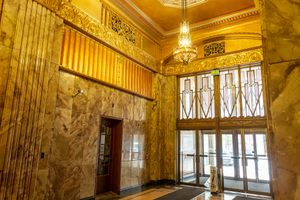About
Downtown Tulsa, Oklahoma contains many examples of Art Deco architecture, but among those many marvels, one building stands out as nearly a parody of the style. The “fauxback” Denver Avenue Station, with its exaggerated Art Deco elements, is not an architectural wonder. Instead, its form tells the story of Tulsa’s boom, protracted decline, and hope for its revival.
Tulsa’s prominence as an Art Deco city is mostly a matter of happenstance. On June 24, 1901, oil shot out 30 feet high at a derrick in what is now the Red Fork neighborhood of southwest Tulsa. The resulting excitement and later, larger discoveries led to a rush of speculation and money into Tulsa, which soon rebranded itself the “Oil Capital of the World.” Large skyscrapers and imposing buildings began to sprout up across the city in the dominant architectural styles of the time.
Among these buildings was a striking opera house known as the Akdar Shrine Temple. The nearly comically opulent “mosque” featured large orange-and-blue Moorish-style towers, and an extravagant interior for first-run movies or the latest Ziegfeld follies. Soon after its 1925 opening, the Great Depression struck Oklahoma hard, and the building closed for many years.
In the 1950s, the Akdar Shrine was revived under a new name, the Cimarron Ballroom. It was a dance hall run by a member of Bob Wills’ Texas Playboys, and featured Western swing and many popular acts. Among those, it was the site of Patsy Cline’s comeback after a near-fatal car accident.
Unfortunately, by the 1960s, the oil money that caused Tulsa’s boom had nearly dried up, as more businesses moved to other cities, such as Houston, and many more companies moved overseas. This long decline had the curious effect of preserving much of its downtown, as new construction dried up. However, urban renewal efforts had taken hold, and under its auspices, many of Tulsa’s downtown buildings were razed, including the Cimarron Ballroom, which was removed in 1973. Many of the remaining buildings were listed as part of the Oil Capital Historic District, so as to fight for its preservation.
The Cimarron Ballroom site was a parking lot for many years, but in 1998, the Metropolitan Tulsa Transit Authority opened a new $3 million central bus station, the first of its kind in the city. As Tulsa was by this point known for its architecture, the bus station was built in an Art Deco style. However, its exaggerated eyebrows and setbacks and its Streamline Moderne-inspired curving form would perhaps be more at home in Miami Beach than in Tulsa, where some see the bus station as garish and inauthentic. Nevertheless, it looks more “Art Deco” than many of the more authentic Art Deco-era buildings nearby, and it makes for a beautiful photo opportunity or welcome to downtown.
Nonetheless, there are serious plans to level the station and to move the central bus station elsewhere in town. The transit system has suffered from decades of neglect of its riders, of whom nearly two-thirds are below the poverty line. The station itself is widely perceived as unsafe and dwell times have swelled, even as Tulsa itself has seen a revival. Although picturesque, this unusual bus station could soon go the way of the Cimarron Ballroom.
Related Tags
Know Before You Go
The Denver Avenue Station remains in continuous operation, serving Tulsa commuters daily. As a public municipal building and transportation hub, it is used safely by many riders each day, but there are both perceived and real safety concerns, so plan accordingly if you intend to pass by.
Published
May 3, 2024
Sources
- https://tulsaworld.com/news/local/history/throwback-tulsa-a-look-back-at-riding-the-bus-in-tulsa/collection_87f05db2-5613-510b-8895-452ad5d4e87d.html#12
- https://www.tulsapeople.com/large-lovely-and-long-gone/article_b928d06d-e4b7-5b5a-8df4-74fb3eaca6c6.html
- https://ou.edu/content/dam/Tulsa/Urban%20Design%20Studio/Archive/2019/Denver_Avenue_Station.pdf
























